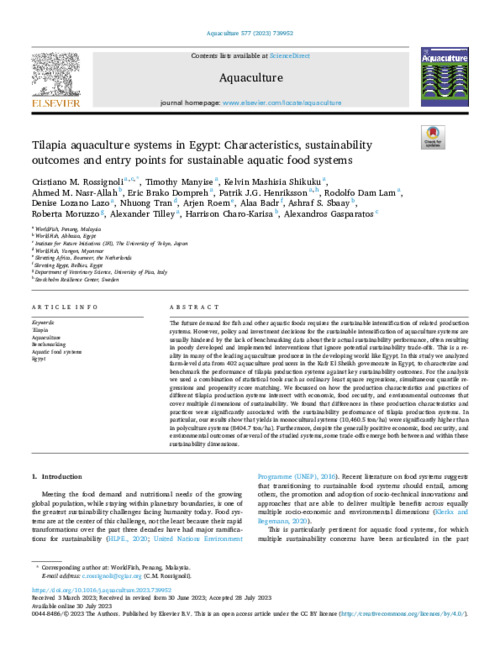Please use this identifier to cite or link to this item:
https://hdl.handle.net/20.500.12348/5595
Tilapia aquaculture systems in Egypt: Characteristics, sustainability outcomes and entry points for sustainable aquatic food systems
| dc.creator | Rossignoli, C. | en_US |
| dc.creator | Manyise, T. | en_US |
| dc.creator | Shikuku, K.M. | en_US |
| dc.creator | Nasr-Allah, Ahmed | en_US |
| dc.creator | Brako Dompreh, E. | en_US |
| dc.creator | Henriksson, P.J. | en_US |
| dc.creator | Dam Lam, R. | en_US |
| dc.creator | Lozano, D.P. | en_US |
| dc.creator | Tran, N. | en_US |
| dc.creator | Roem, A. | en_US |
| dc.creator | Badr, A. | en_US |
| dc.creator | Sbaay, A.S. | en_US |
| dc.creator | Moruzzo, R. | en_US |
| dc.creator | Tilley, A. | en_US |
| dc.creator | Karisa, H.C. | en_US |
| dc.creator | Gasparatos, A. | en_US |
| dc.date.accessioned | 2023-08-08T16:33:29Z | |
| dc.date.available | 2023-08-08T16:33:29Z | |
| dc.date.issued | 2023 | en_US |
| dc.identifier.citation | Cristiano Rossignoli, Timothy Manyise, Kelvin Shikuku, Ahmed Nasr-Allah, Eric Brako Dompreh, Patrik Henriksson, Rodolfo Dam Lam, Denise Lozano, Nhuong Tran, Arjen Roem, Alaa Badr, Ashraf Sbaay, Roberta Moruzzo, Alexander Tilley, Harrison Karisa, Alexandros Gasparatos. (30/7/2023). Tilapia aquaculture systems in Egypt: Characteristics, sustainability outcomes and entry points for sustainable aquatic food systems. Aquaculture, 577. | en_US |
| dc.identifier.issn | 0044-8486 | en_US |
| dc.identifier.issn | 1873-5622 | en_US |
| dc.identifier.uri | https://hdl.handle.net/20.500.12348/5595 | |
| dc.description.abstract | The future demand for fish and other aquatic foods requires the sustainable intensification of related production systems. However, policy and investment decisions for the sustainable intensification of aquaculture systems are usually hindered by the lack of benchmarking data about their actual sustainability performance, often resulting in poorly developed and implemented interventions that ignore potential sustainability trade-offs. This is a reality in many of the leading aquaculture producers in the developing world like Egypt. In this study we analyzed farm-level data from 402 aquaculture producers in the Kafr El Sheikh governorate in Egypt, to characterize and benchmark the performance of tilapia production systems against key sustainability outcomes. For the analysis we used a combination of statistical tools such as ordinary least square regressions, simultaneous quantile regressions and propensity score matching. We focussed on how the production characteristics and practices of different tilapia production systems intersect with economic, food security, and environmental outcomes that cover multiple dimensions of sustainability. We found that differences in these production characteristics and practices were significantly associated with the sustainability performance of tilapia production systems. In particular, our results show that yields in monocultural systems (10,460.5 ton/ha) were significantly higher than in polyculture systems (8404.7 ton/ha). Furthermore, despite the generally positive economic, food security, and environmental outcomes of several of the studied systems, some trade-offs emerge both between and within these sustainability dimensions. | en_US |
| dc.format | en_US | |
| dc.language | en | en_US |
| dc.publisher | Elsevier Ltd. | en_US |
| dc.rights | CC-BY-4.0 | en_US |
| dc.source | Aquaculture;577,(2023) | en_US |
| dc.subject | aquatic food systems | en_US |
| dc.subject | benchmarking | en_US |
| dc.title | Tilapia aquaculture systems in Egypt: Characteristics, sustainability outcomes and entry points for sustainable aquatic food systems | en_US |
| dc.type | Journal Article | en_US |
| cg.coverage.country | Egypt | en_US |
| cg.coverage.region | Northern Africa | en_US |
| cg.subject.agrovoc | aquaculture | en_US |
| cg.subject.agrovoc | egypt | en_US |
| cg.subject.agrovoc | tilapia | en_US |
| cg.subject.agrovoc | Fish | en_US |
| cg.contributor.affiliation | WorldFish | en_US |
| cg.contributor.affiliation | Stockholm Resilience Centre | en_US |
| cg.contributor.affiliation | The University of Tokyo | en_US |
| cg.contributor.affiliation | University of Pisa | en_US |
| cg.contributor.affiliation | Skretting | en_US |
| cg.identifier.status | Open access | en_US |
| cg.identifier.ISIindexed | ISI indexed | en_US |
| cg.contribution.worldfishauthor | Rossignoli, C. | en_US |
| cg.contribution.worldfishauthor | Manyise, T. | en_US |
| cg.contribution.worldfishauthor | Shikuku, K.M. | en_US |
| cg.contribution.worldfishauthor | Nasr-Allah, Ahmed | en_US |
| cg.contribution.worldfishauthor | Brako Dompreh, E. | en_US |
| cg.contribution.worldfishauthor | Henriksson, P.J. | en_US |
| cg.contribution.worldfishauthor | Dam Lam, R. | en_US |
| cg.contribution.worldfishauthor | Lozano, D.P. | en_US |
| cg.contribution.worldfishauthor | Tran, N. | en_US |
| cg.contribution.worldfishauthor | Sbaay, A.S. | en_US |
| cg.contribution.worldfishauthor | Tilley, A. | en_US |
| cg.contribution.worldfishauthor | Karisa, H.C. | en_US |
| cg.description.theme | Sustainable aquaculture | en_US |
| dc.identifier.doi | https://dx.doi.org/10.1016/j.aquaculture.2023.739952 | en_US |
| cg.creator.id | Cristiano Rossignoli: 0000-0001-8220-7360 | en_US |
| cg.creator.id | Timothy Manyise: 0000-0003-1951-9892 | en_US |
| cg.creator.id | Kelvin Mashisia Shikuku: 0000-0003-2290-074X | en_US |
| cg.creator.id | Ahmed Mohamed Nasr-Allah: 0000-0001-6299-8556 | en_US |
| cg.creator.id | Patrik John Gustav Henriksson: 0000-0002-3439-623X | en_US |
| cg.creator.id | Rodolfo Dam Lam: 0000-0001-5987-3592 | en_US |
| cg.creator.id | Nhuong Tran: 0000-0002-1813-4571 | en_US |
| cg.creator.id | Ashraf Shabaan Sbaay: 0000-0001-5678-7488 | en_US |
| cg.creator.id | Alexander Tilley: 0000-0002-6363-0945 | en_US |
| cg.creator.id | Harrison Charo Karisa: 0000-0001-5323-794X | en_US |
Files in this item
This item appears in the following Collection(s)
-
Sustainable aquaculture [2735]
